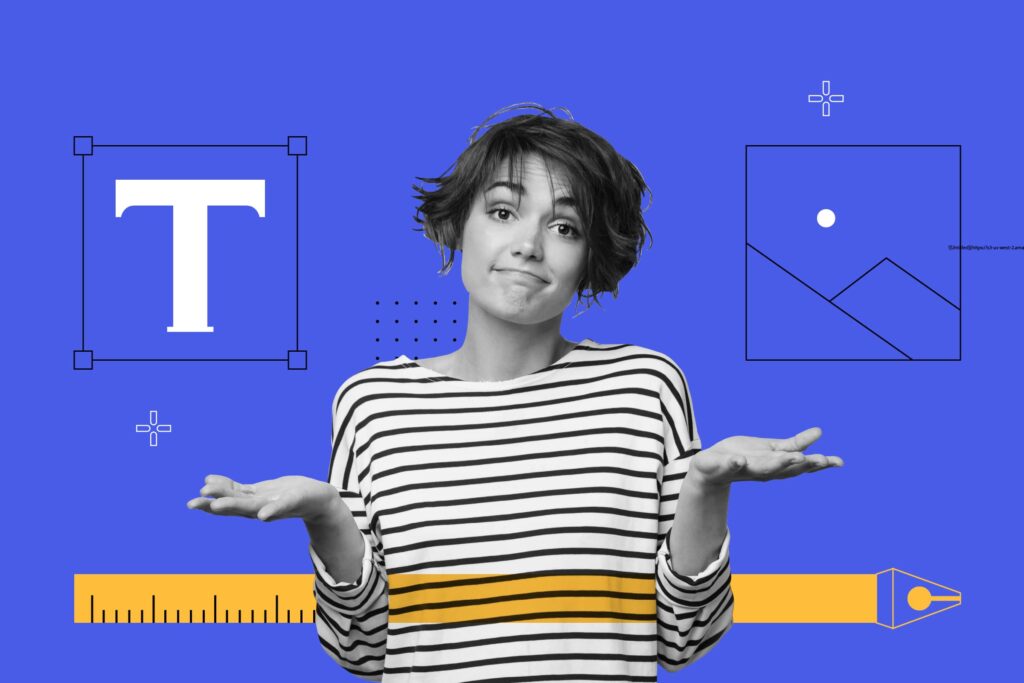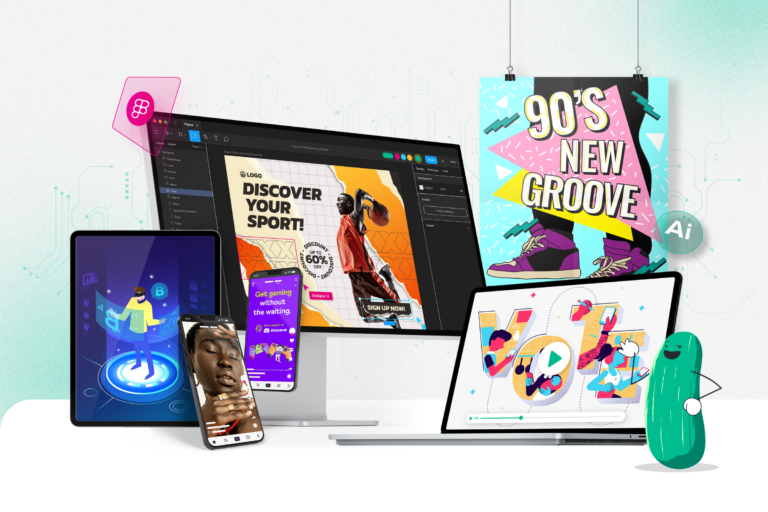Graphic Design vs. Illustration: What’s The Difference?
Everyone knows that the best brands are the best visual communicators. Visual communication is how a brand stands out from the pack, builds a unique presence, and remains memorable. Visual branding is all around us, from the Nike swoosh to Mr. Clean, and each one has the power to trigger a memory or evoke an emotion. But did you know that the Nike swoosh and Mr. Clean are actually two very different things? In the art world, one would be considered a “design,” and the other would be an “illustration.”
Graphic design and illustration are both important visual communication methods, and they often involve similar tools and skillsets, so it’s easy to misunderstand the terms. And when we’re talking about new, unique visuals, it can be challenging to describe your idea — let alone know how to categorize it. But a better understanding of the two, and the differences between them, helps you communicate with designers and art directors, so you get the artwork you love faster.

All About Illustration
Illustrators create a work of art that visualizes a story, idea, or subject. It can be as simple as a piece of clip art, or complex as the illustration in a children’s book, however, it focuses on creative interpretation. An illustration art can be realistic or abstract, with a vast range of styles and subjects. In the simplest terms, an illustration is almost any form of visual representation that isn’t photography: if the artist creates it from their imagination, it’s an illustration.
Illustration Tools
Many illustrators have classical art backgrounds and work with tools (at least in the beginning) like pencils or brushes. They often then digitize their work, and either finish it, or work from beginning to end, in software like Adobe Photoshop, Adobe Illustrator, ArtRage, or entire suites of drawing, painting, and sketching tools.
Great Ways to Use Illustration
- Illustrations are ideal for capturing abstract concepts. For example, it’s easy to represent a “coffee cup” with a photograph, but more difficult to visually convey something like “energy.”
- Illustrations are also great for capturing the desired tone or quality in an image. Again, it’s easy to photograph a “coffee cup,” but harder to communicate a “happy coffee cup.
- Illustrations are perfect for creating unique, memorable images. Illustrators are artists, after all, and create distinctive artwork that doesn’t look like anything else. The works of Norman Rockwell, for example, became iconically linked to the Saturday Evening Post:

Related Articles
5 Things to Consider When Rebranding
Designer-Speak for Clients Vol. 1: Basic Design Principles
8 Graphic Design Essentials for Every Business

All About Graphic Design
To better understand graphic design, it’s best to begin by defining what designers mean when they talk about “graphics.” A “graphic” refers to just about any single visual element in a composition, including illustrations, photographs, logos, symbols, and other visual elements like lines, borders, etc. A “graphic,” in other words, is everything in a composition that isn’t text.
Graphic designers work with both graphics and text to create comprehensive designs. When a graphic designer works on a company logo, for example, they may combine illustrations (like the Starbucks mermaid) with text, circles, stars, and other graphic elements to create a single logo. Graphic designers work with fonts, colors, composition, and layout. A graphic designer places visual elements in relationship to each other, creating a single cohesive design from all the components.
Graphic Design Tools
In the olden days, visual compositions were often done manually by physically cutting and pasting different things together to be copied and printed in an old-fashioned print shop. Today, most graphic design is digital, using tools like Adobe Photoshop, Adobe Illustrator, Adobe InDesign, and a host of other image creation, manipulation, and layout tools for digital images.
Areas of Possible Application
- To create clarity. Today, the Nike logo is iconic and doesn’t require text, but it wasn’t always that way. Incorporating copy into a graphic can help to make the message very clear.
- To create cohesion. Graphic designers choose colors, fonts, size, and scale, and make sure that all the design elements work together.
- Ideal for creating brand logos. If you can’t tell by now, graphic design is perfect for creating logos and brand imagery. Whether the logo includes an illustration or not, the graphic designer considers all the visual arts and messaging and pulls it together.
What About Graphic Illustration?
Graphic illustration is an expression of the characteristics of graphic design and illustration in one piece of work. It combines visual elements such as colors, lines, shapes, forms, and layout texts with fine art. When you have both worlds of graphic and illustration combined together in one piece of work, then you can have an illustrated graphic, design illustration, or illustrated graphic design.
A graphic illustrator understands how to use the principles of fine art to paint a stylistic picture while also incorporating other elements that will help to create a connection between users and products or brands.
More Examples of the Differences between Graphic Design and Illustration

An excellent example of the difference between graphic design and illustration is the typical cover of New Yorker Magazine — which generally features a prominent illustration: a work of art that visualizes the subject within, including the mood and tone of the content. But the entire cover, with the artwork, layout, text, fonts, colors, and the way those elements interact with each other, is the work of a graphic designer. New Yorker Magazine is rightfully famous for its iconic illustrations but still uses graphic design.

In contrast, the cover of Time magazine typically uses photographs, so the main artwork isn’t created by an illustrator. But, again, the entire look and feel of the cover, including the photograph, is done by a graphic designer.

The logo for Starbucks coffee famously includes an illustration of a mermaid. Although the logo has evolved over the years, the mermaid imagery anchors the design and remains recognizable — the periodic revisions in text, size, colors, and so on, have been done by a graphic designer.
Graphic Design vs Illustration vs Graphic Illustration
Between these three, what should you choose for your marketing campaign? If you just need to communicate your brand’s uniqueness with logos, typography, colors, and images, graphic design is what you need.
If you need an illustrated character to act as the face of your company, then illustration is what to consider. However, if your brand is looking for a stylistic approach to your marketing strategy in addition to your brand elements, you can consider graphic illustration.
Graphic design and illustration both play an essential part in marketing, branding, and growing a business. After all, crafting a brand story is a crucial aspect of differentiating a brand and building customer loyalty, and a story simply isn’t complete without pictures.
That’s why Design Pickle is proud to bring you Custom Illustrations, a new service that offers unique, custom illustrations on demand. Our world-class illustrators are ready to create stunning artwork for you with the same high standards, service, and professionalism as Design Pickle’s regular graphic design service.
Learn more about Custom Illustrations today for original artwork made easy.







